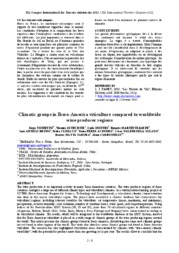Climatic groups in Ibero-America viticulture compared to worldwide wine producer regions.
Climatic groups in Ibero-America viticulture compared to worldwide wine producer regions.
Autoria: TONIETTO, J.; SOTÉS RUIZ, V.; MONTES, C.; MARTÍN ULIARTE, E.; ANTELO BRUNO, L.; CLÍMACO, P.; PÉREZ ACEVEDO, Y.; VALENZUELA-SOLANO, C.; HATTA SAKODA, B.; CARBONNEAU, A.
Resumo: The wine production is an important activity in many Ibero-American countries. The wine producer regions of these countries configure a large use of different climate types and viticultural climates. In a vitivinicultural zoning project of CYTED (Ibero-American Program for Science, Technology and Development), a viticultural climatic characterization was done in this macro viticultural region. The project have assembled a climatic database that characterizes the viticultural regions, including relevant variables for viticulture: air temperature (mean, maximum, and minimum), precipitation, relative humidity, solar radiation, number of sunshine hours, wind speed, and evapotranspiration. Using indices of the Geoviticulture MCC System (HI, CI and DI), more than 70 viticultural regions in different countries (Argentina, Bolivia, Brazil, Chile, Cuba, Spain, Mexico, Peru, Portugal and Uruguay) were characterized according to its viticultural climatic. The results, which will be integrated to the worldwide database of the MCC System, showed that the Ibero-American viticulture is placed in a wide range of climatic groups of the wine producing regions around the world. This article presents the climatic groups found in Ibero-America, identifying also some new climatic groups not yet found in other regions of the world. This work also identifies some climatic groups not found in Ibero-America viticulture. The research has also highlighted viticultural areas characterized by climates with ?intra-annual climatic variability?, with the potential to produce more than one growing cycle per year. The results allow to conclude that the wide variability and climatic diversity present in Ibero-America may be one of the reasons to explain the diversity in terms of wine types, sensorial characteristics, typicity and uniqueness of wines produced on this macro-region.
Ano de publicação: 2012
Tipo de publicação: Artigo em anais e proceedings
Unidade: Embrapa Uva e Vinho
Palavras-chave: Clima, Iberoamérica, Mercado, Producao, Produção mundial, Uva, Vinho, Viticultura
Observações
1 - Por padrão são exibidas publicações dos últimos 20 anos. Para encontrar publicações mais antigas, configure o filtro ano de publicação, colocando o ano a partir do qual você deseja encontrar publicações. O filtro está na coluna da esquerda na busca acima.
2 - Para ler algumas publicações da Embrapa (apenas as que estão em formato ePub), é necessário ter, no celular ou computador, um desses softwares gratuitos. Sistemas Android: Google Play Livros; IOS: iBooks; Windows e Linux: software Calibre.
Acesse outras publicações
Acesse a Base de Dados da Pesquisa Agropecuária (BDPA) para consultar o acervo completo das bibliotecas da Embrapa.

